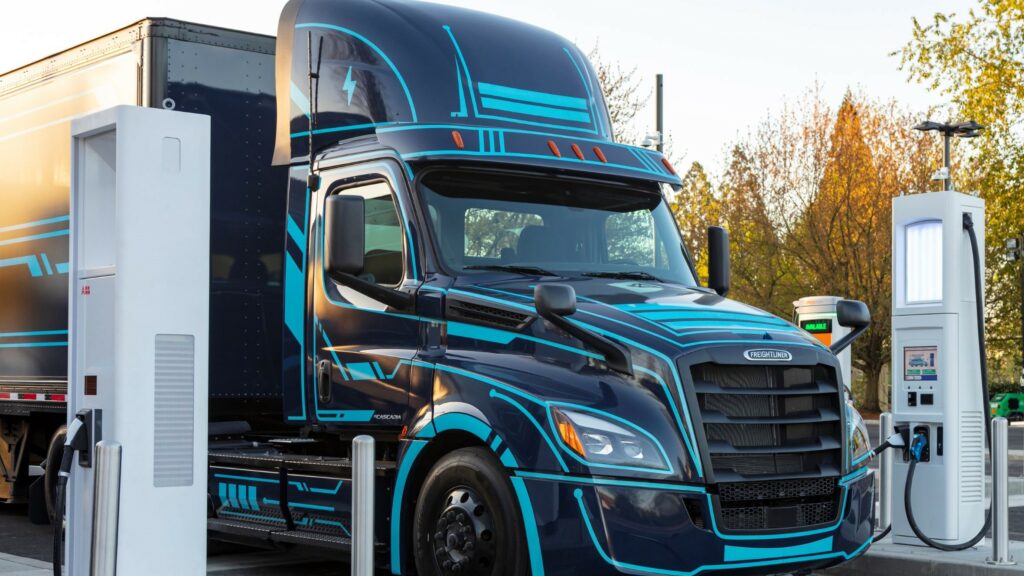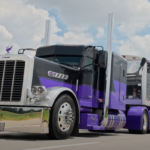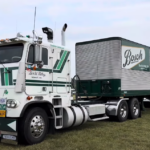This week, members of a trucking organization conveyed their concerns to government officials regarding regulations aimed at reducing emissions in the freight industry. They pointed out that these regulations do not adequately address the need to establish a nationwide charging system to support heavy-duty battery-electric vehicles.
On Thursday, leaders from the Clean Freight Coalition (CFC) met with representatives from the Joint Office of Energy and Transportation. The purpose of this meeting was to discuss the challenges and opportunities involved in transitioning the nation’s commercial truck fleet to low- and zero-emission vehicles. The CFC, which consists of various stakeholders in the freight transportation sector, is dedicated to achieving a zero-emission future and has been educating policymakers on this matter since its launch in March.
The Joint Office was established as part of the Bipartisan Infrastructure Law with the goal of fostering collaboration between the Departments of Energy and Transportation to deploy an extensive network of electric vehicle chargers and zero-emission fueling infrastructure.
During the meeting, the CFC emphasized the importance of considering the heavy-duty sector when allocating federal funds. They referred to a significant “infrastructure gap” as a major obstacle in smoothly transitioning away from carbon-based fuels, urging policymakers to prioritize addressing this issue promptly.
“One of the fatal flaws in California’s electric-truck mandates is that the infrastructure buildout is lightyears behind the hyper-aggressive timelines set forth in regulation,” said CFC Executive Director Jim Mullen.
“By trying to force the trucking industry to electrify without the charging infrastructure and power capacity that will be required, the state is setting trucking and the supply chain up for failure. That’s why in our meeting with the Joint Office today we stressed why EPA should not propose ZEV-dependent rules prior to ensuring the necessary resources are actually in place.”
The scalable deployment of medium- and heavy-duty battery-electric trucks, as envisioned by the EPA’s GHG3 rulemaking, would require the installation of a significant number of chargers. According to an analysis conducted by Ricardo Strategic Consulting for the Truck and Engine Manufacturers Associations in June, a staggering 15,625 chargers must be installed every month from now until 2032 to achieve this goal.
However, despite the pressing need for charging infrastructure, no state has allocated any funds from the National Electric Vehicle Infrastructure (NEVI) grant program specifically for medium- and heavy-duty charging infrastructure. This lack of funding, as mentioned in a statement from the coalition, poses a significant challenge to the successful implementation of the EPA’s GHG3 rulemaking.
To make charging practical for complex truck driving schedules, it is essential to have charging stations located at existing truck parking spots along interstate routes. Unfortunately, the trucking industry is currently facing a chronic shortage of commercial truck parking spaces across the entire nation, as stated in a statement from the CFC. This shortage further complicates the efforts to establish the necessary charging infrastructure for electric trucks.
A number of trucking industry leaders weighed in on the issue. They included:
- Dan Van Alstine, chairman of the American Trucking Associations and President and Chief Operating Officer at Ruan Transportation Management Systems.“We need to get this right, which frankly the consequences are too great. It’s critical that any regulatory framework is connected to the realities of trucking operations. That is the key to success, and that is why we are here in Washington having these conversations today.”
- Scott McCandless, chairman of the American Truck Dealers “The trucking industry needs adequate lead times across all market segments to ensure these vehicles are affordable and supported by the necessary infrastructure. It is troubling that government is pushing the regulation of zero-emission vehicles in a way that could slow down rather than accelerate the adoption by truck customers.”
- Andy Richard, chief executive officer of Sapp Bros. “Policies shouldn’t ignore the lower-carbon fuels that are at our disposal today. A market-driven, technology-neutral approach will advance the adoption of alternative fuels without picking winners and losers. Biodiesel and renewable diesel represent the best option that fleets have today to reduce their carbon emissions, and this will be the case for the foreseeable future. The right policies will encourage fuel retailers to make these investments without sacrificing efforts on electrification, hydrogen or other next-generation fuels.”
- Jim Ward, president of the Truckload Carriers Association “The ‘essentiality’ of trucking to the supply chain became quite obvious during the pandemic. and our members remain committed to keeping America moving. To continue providing the quality of service the general public has come to expect, motor carriers must have reliable, affordable, and safe equipment available to them.”
- Ryan Streblow, president and CEO of the National Tank Truck Carriers. “The entire transportation ecosystem is at risk. The tank truck industry envisions low and zero-emission commercial trucks, but current timelines and goals must account for technology availability, affordability, infrastructure overall, and a scalable energy source.”
- Debbie Sparks, executive director of the National Motor Freight Traffic Association. “NMFTA stands with our industry peers to amplify our concerns and needs for more effective solutions.”
In addition to their efforts mentioned earlier, the Clean Freight Coalition (CFC) took the initiative to meet with various lawmakers on Capitol Hill. The purpose of these meetings was twofold: first, to express their concerns regarding the EPA’s GHG3 rulemaking, and secondly, to advocate for the repeal of the federal excise tax.
The CFC believes that repealing the federal excise tax would have significant and immediate positive effects on emissions reduction. This tax repeal would facilitate the process of replacing the nation’s aging truck fleet with newer, cleaner, and safer models currently available in the market.
By supporting the transition to more environmentally friendly and technologically advanced trucks, the CFC aims to bring about substantial emissions reductions, benefiting both the environment and public safety.





